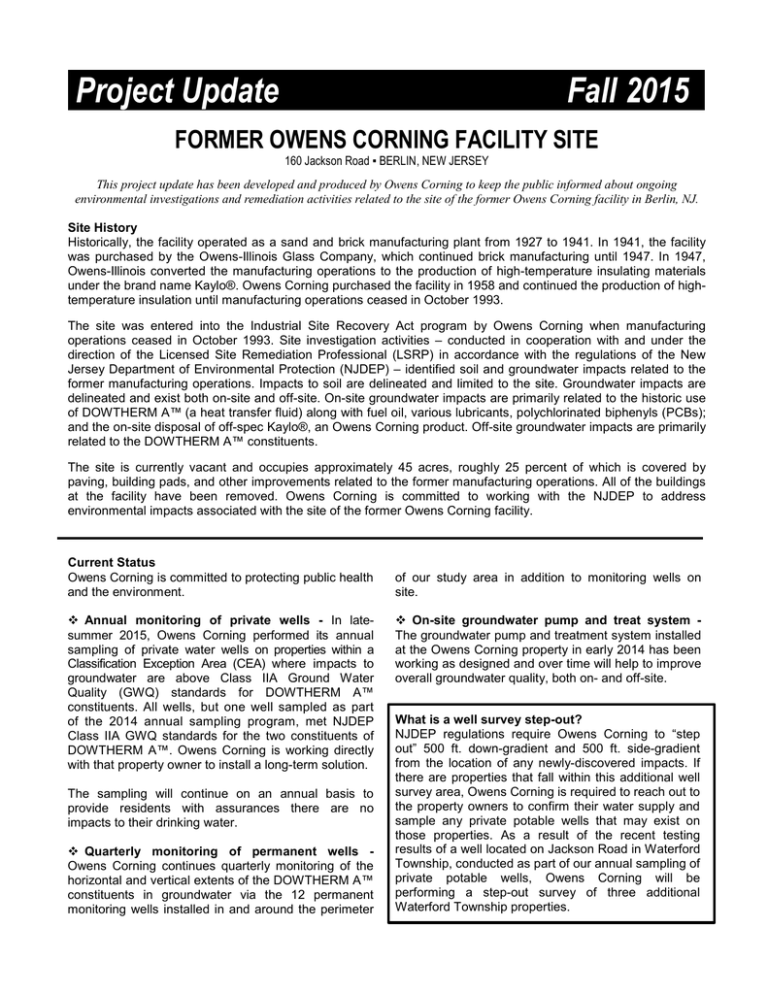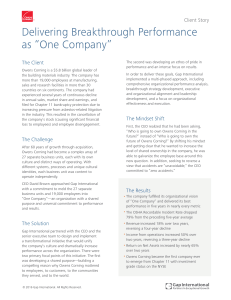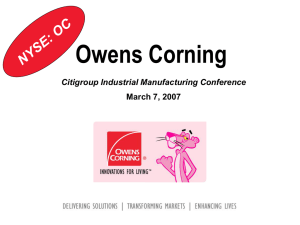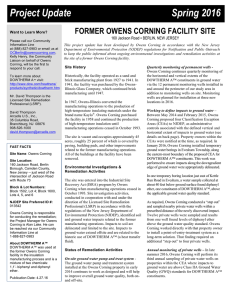Fall 2015 Project Update
advertisement

Project Update Fall 2015 FORMER OWENS CORNING FACILITY SITE 160 Jackson Road ▪ BERLIN, NEW JERSEY This project update has been developed and produced by Owens Corning to keep the public informed about ongoing environmental investigations and remediation activities related to the site of the former Owens Corning facility in Berlin, NJ. Site History Historically, the facility operated as a sand and brick manufacturing plant from 1927 to 1941. In 1941, the facility was purchased by the Owens-Illinois Glass Company, which continued brick manufacturing until 1947. In 1947, Owens-Illinois converted the manufacturing operations to the production of high-temperature insulating materials under the brand name Kaylo®. Owens Corning purchased the facility in 1958 and continued the production of hightemperature insulation until manufacturing operations ceased in October 1993. The site was entered into the Industrial Site Recovery Act program by Owens Corning when manufacturing operations ceased in October 1993. Site investigation activities – conducted in cooperation with and under the direction of the Licensed Site Remediation Professional (LSRP) in accordance with the regulations of the New Jersey Department of Environmental Protection (NJDEP) – identified soil and groundwater impacts related to the former manufacturing operations. Impacts to soil are delineated and limited to the site. Groundwater impacts are delineated and exist both on-site and off-site. On-site groundwater impacts are primarily related to the historic use of DOWTHERM A™ (a heat transfer fluid) along with fuel oil, various lubricants, polychlorinated biphenyls (PCBs); and the on-site disposal of off-spec Kaylo®, an Owens Corning product. Off-site groundwater impacts are primarily related to the DOWTHERM A™ constituents. The site is currently vacant and occupies approximately 45 acres, roughly 25 percent of which is covered by paving, building pads, and other improvements related to the former manufacturing operations. All of the buildings at the facility have been removed. Owens Corning is committed to working with the NJDEP to address environmental impacts associated with the site of the former Owens Corning facility. Current Status Owens Corning is committed to protecting public health and the environment. Annual monitoring of private wells - In latesummer 2015, Owens Corning performed its annual sampling of private water wells on properties within a Classification Exception Area (CEA) where impacts to groundwater are above Class IIA Ground Water Quality (GWQ) standards for DOWTHERM A™ constituents. All wells, but one well sampled as part of the 2014 annual sampling program, met NJDEP Class IIA GWQ standards for the two constituents of DOWTHERM A™. Owens Corning is working directly with that property owner to install a long-term solution. The sampling will continue on an annual basis to provide residents with assurances there are no impacts to their drinking water. Quarterly monitoring of permanent wells Owens Corning continues quarterly monitoring of the horizontal and vertical extents of the DOWTHERM A™ constituents in groundwater via the 12 permanent monitoring wells installed in and around the perimeter of our study area in addition to monitoring wells on site. On-site groundwater pump and treat system The groundwater pump and treatment system installed at the Owens Corning property in early 2014 has been working as designed and over time will help to improve overall groundwater quality, both on- and off-site. What is a well survey step-out? NJDEP regulations require Owens Corning to “step out” 500 ft. down-gradient and 500 ft. side-gradient from the location of any newly-discovered impacts. If there are properties that fall within this additional well survey area, Owens Corning is required to reach out to the property owners to confirm their water supply and sample any private potable wells that may exist on those properties. As a result of the recent testing results of a well located on Jackson Road in Waterford Township, conducted as part of our annual sampling of private potable wells, Owens Corning will be performing a step-out survey of three additional Waterford Township properties. WHAT IS A CEA? A CEA is an administrative control that identifies for state and county officials the horizontal and vertical extents of groundwater impacts. For the purposes of protecting public health and safety, a CEA is sometimes coupled with a Well Restriction Area (WRA) to enable the application of restrictions to access or use of the impacted groundwater via private wells. However, a CEA doesn’t automatically have a Well Restriction Area. As part of its work, Owens Corning has established four Classification Exception Areas (CEAs). They include: A CEA with a WRA: In May 2014, Owens Corning proposed a CEA for properties where impacts to groundwater are above Class IIA Ground Water Quality standards ™ for DOWTHERM A constituents, in accordance with the defined regulatory process for submitting its Site Remedial Investigation Report to the NJDEP. Property owners within the proposed CEA/WRA with well restrictions were notified in April 2014 and are included in Owens Corning’s annual monitoring program. The well restriction does not prohibit wells, but provides guidelines regarding well construction. A CEA with no well restriction area: In December 2014, Owens Corning notified property owners within a second tier of the CEA, in accordance with NJDEP requirements for the New Jersey Pinelands. This portion of the CEA defines impacts to groundwater that exceed the Class I GWQ environmental standards of the New Jersey Pinelands only. There are no associated well restrictions and, as such, these properties are not included in the annual well monitoring. A CEA for dibenzofuran: In December 2014, Owens Corning notified property owners of a CEA in a limited area east of its former location. The CEA is related to dibenzofuran, which was not used or manufactured by the former plant’s operations, but can be created when DOWTHERM A™ decomposes under high heat, such as the high temperatures used in the manufacturing process. A CEA with a WRA on Owens Corning’s property: In February 2015, Owens Corning notified local officials of a CEA and WRA for constituents found only on-site at the former facility. There are no impacts from the constituents in this CEA and WRA to surrounding properties. Class I refers to groundwater of Special Ecological Significance, such as the Pinelands area. Class IIA refers to groundwater for the Potable Water Supply Owens Corning’s testing is focused on the two constituents of DOWTHERM A™ 1,1-Biphenyl and Diphenyl ether When results show levels of these constituents above the applicable groundwater quality standards, Owens Corning will work with the property owner to address both near-term and long-term water supply needs for use with drinking and cooking. Near-Term Solution Bottled water will be provided within five days and until a long-term solution is implemented (no more than 60 days). Long-Term Solution A granular activated carbon filtration system is an effective long-term solution for addressing constituents related to the Owens Corning site and for ensuring safe, potable water related to these constituents. Owens Corning has contracted with a local representative of Paragon Resource Management, Inc. to design, supervise, and manage the installation and maintenance of a filtration system appropriate to the needs of the well owner. There is no cost to the property owner for these services. Want More Information? Call our Community Information Line at 1-888-827-0983 Email us at: OCBerlin@owenscorning.com Visit our website at: occommunityinformationsite.com


